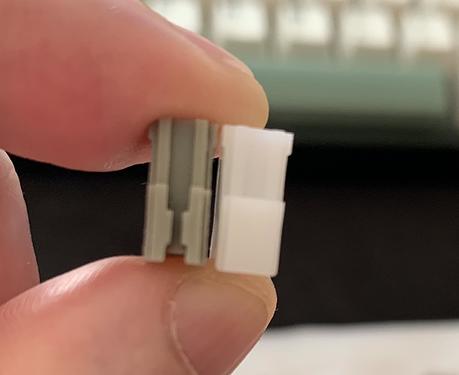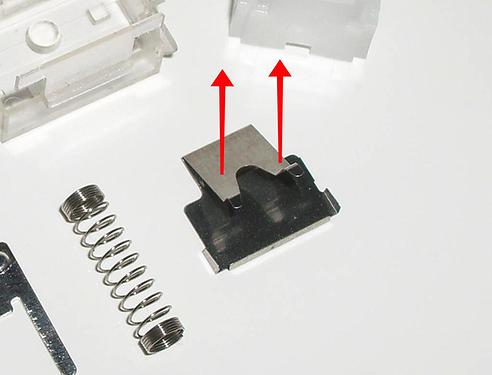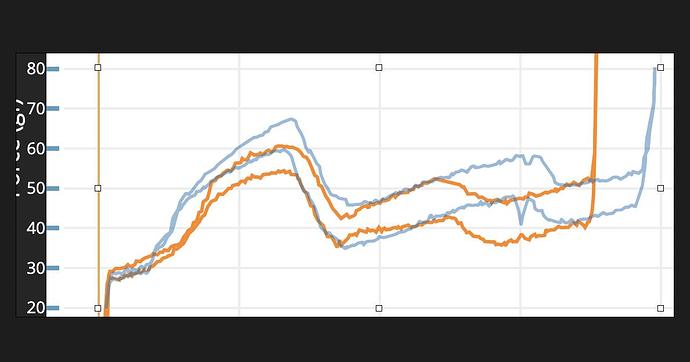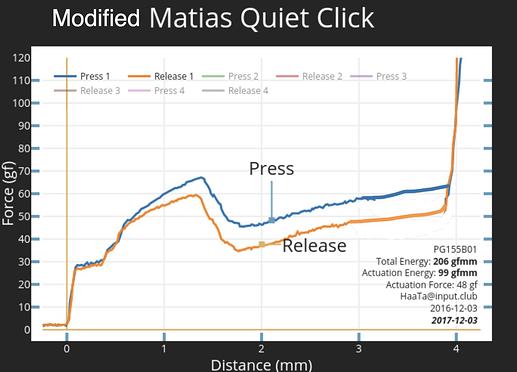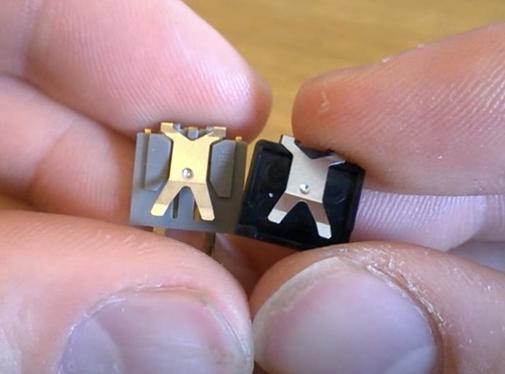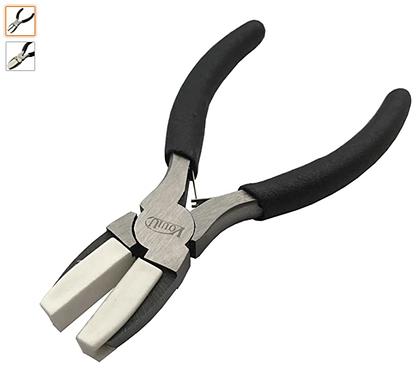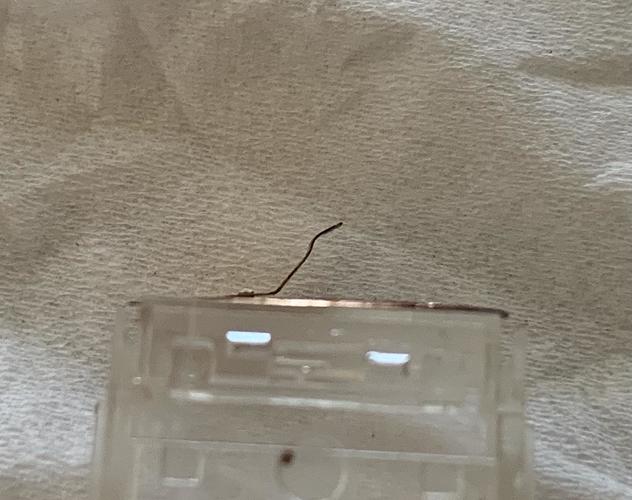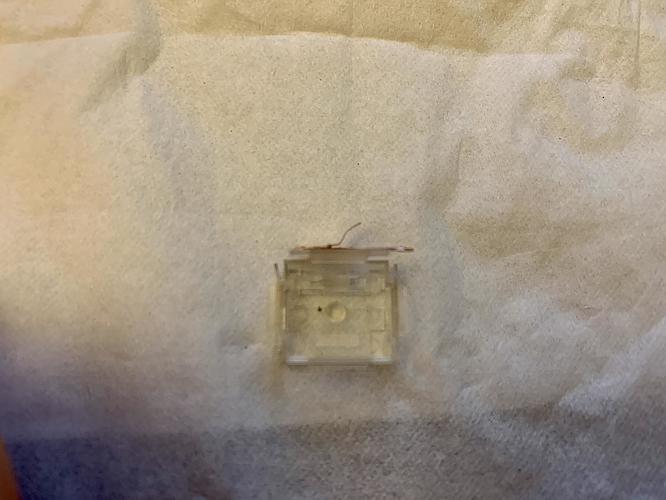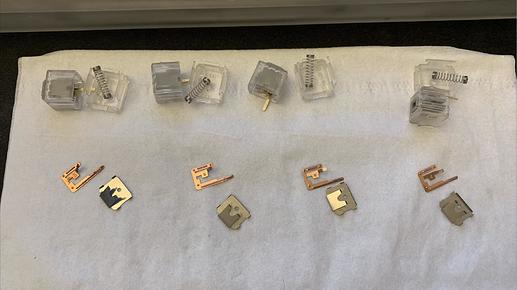Welcome lispnick 
There is one unpleasant experience I had with removing the rubber. Sometimes, the switch gets stuck in the housing as the shorter slider moves too low in the switch and becomes blocked by the upper housing. I usually swap the stems and use the white stem from MCs in the QCc, then the problem does not appear. By the way, Chyros has a video where he experiments with swapped sliders and compares the feel.
I have not yet experienced that. Checking the difference with stems in hand, the difference is very small, under 200 micrometer?
Saw the video and tried exchanging tactile leaf but didn’t like the result because MC clicker leaf not being fixed at top was making it sound dirty.
But I found that just pulling the hanging-end of the tactile leaf outward more increased tactility. If this doesn’t interferes with switch operation, it’s basically choose-your-own-tactility hack.
Yes, that definitely works. It is also interesting to combine that with a lighter spring (SPRiT Alps springs) because stiffer springs tend to suppress the tactile feel.
The challenge is, of course, how to bend the leafs consistently across all switches in a keyboard. In my experience even a small deviation can be felt. I was thinking about making a set of clamps, each for a different angle, but have not enough time to get to it seriously.
Yeah. That’s what the jigs are for. Before a jig is built, I’m thinking about using a simple wedge made out of paper to check if the adjusted angle matches. Not exactly precise but precise enough for my level of sensitivity…I’m hoping.
Anyway, the modified QC with all the hacks mention above plus lubing now feels really good. Won’t know how it’ll finally sounds until a board is built but happy with what I have now.
Comparison chart of SKCM Orange (orange) and Matias Quiet Click (light blue overlay)
Some observations:
- QC’s first bump rises faster and higher with sharp peak.
- Orange’s first is more gradual with inclined plateau ~0.8mm long.
- First bump ends at similar location for both switches but Orange ends more sharply.
- Orange’s gentle incline to second tactile event lasts ~0.7mm where QC lasts much longer.
- Orange’s gentle incline to second tactile event peaks is at ~2.4mm where QC peaks at 3mm.
- Orange gently swoops after 2nd peak for a full millimeter where QC drops fast then liner for much shorter distance.
- Orange key travel is 3.5mm where QC is 4mm.
Putting it together:
- Orange has gentler first bump quickly followed by a long rolling bump.
- QC has sharper initial bump then a prolonged linear like run until secondary bump just before ends.
It would be extremely interesting to observe how the modifications influence the force curves.
Force graph after straightening the protruding arm would be something like this which matches the actual feel. As I wrote before, close to a linear except for the bump at the top.
I tried adding two bends to reproduce Orange’s 2nd bump. Resulting QC felt wiggly after the first bump which made the switch more fun. But I don’t think I can produce with a flimsy copper arm what SKCM Orange does with a butterfly wing like mechanism.
From one of Chyrosran22’s videos on ALPS
Anyway, I liked the wiggly feel so I’m going to look into finding a plier that’ll add the wiggly bends reliably. Wire-bending thingamajigs won’t work. Special pliers used by jewelry makers may although thicker contact leaf will be needed to feel the second bump more clearly.
UPDATE: On second thought, I could just take a regular flat plier and tape/glue steel wires on the flat surface to act as template. Easier to make than finding a plier with right kind of curves.
UPDATE2: Found that switch contact is unreliable with extra bends, a show-stopper.
With better understanding of how ALPS clicker and contact leaves work, I watched Chyrosan22’s video again for more insights.
https://youtu.be/57HPGCdBFwk?t=177
And there it was. What I called bufferfly wing was the original contact leaf. SKCM Brown’s infamous force graph was from having two butterflies, the contact leaf and exactly same one on the other side of the stem like being sandwiched by cough well-endowed twins.
Bent sheet-version started later, with SKCM Orange and SKCM Blue, one with bracer to prevent the leaf from being pulled forward to make tactile switch and one without to make clicky switches.
So what got lost in Matias switch is the butterfly wing. What I can’t help wondering is what would it take to remake switches using the butterfly wings? I mean, it looks simple enough to just stamp them out of sheet metal if there was a mold.
After previous post, I went to play a bit more with QC arm and got something that felt interesting without sacrificing reliable switch contact. How interesting? It feels like double humps, one large followed immediately by a smaller one. Even when pressed fast the feeling of having passed through two humps lingers. Bends I added are easily reproducible, at least by me. Now the question is whether it’s daily-used-full-board interesting.
Found a tool for more consistently bending contact leaf: nylon jaw pliers.
That is, assuming nylon pads can be easily grinded to the shape I want.
Matias switches are a clone of the simplified Alps, where the classic contact mechanism has been replaced by a cheaper solution (two bent contacts put in the housing). I think this is the hardest point in recreating SKCM Alps—to make a duplicate of the contact plate that is perfectly synced with the clicker or the tactile leaf to give the exact feeling as the complicated Alps. Without the original tooling, this would require a large investment.
I don’t think we need to duplicate the exact feeling. Instead, we can just bring back what we liked about ALPS to make better switches.
Re perfectly syncing leaf and clicker, I’m not sure what you mean. Being out of sync is why SKCM Orange has the second bump. As to SKCM Brown, they used the same mold for both leaves.
In my [contact] arm twisting experiments yesterday, I bent the arm too early in the first try the second bump disappeared into the first bump. Only after bending a bit later, the second bump could be felt. So I think the focus should be on what feels good and not on whether it’s exactly same. My focus goes a little beyond that, to have fun while doing so.
SKCM Browns also use a plastic switch plate to hold the extra actuation leaf used for tactility. I personally believe that has a lot to do with its unique feel.
Not having any SKCM Browns to test with sucks but I think you may be right. Sadly, I think the Matias QC mod I stumbled into may be the best I can manage at this time. It now feels like one large rounded bump with a noticeable dimple in the middle. Very pleasant to press but won’t know for sure until a board is built and used for a while.
This is what what I’m now calling the dimple leaf looks like:
Angle of the protruding arm is a bit steeper and there is now double bend farther up than what unmodified QC comes with. Steeper angle and location of the double-bend relative to the tactile leaf on the other-side are important. The dimple mod feels good and, thankfully, switch contact operation remain functional.
With 200 QCs in hand, I tried simplifying the dimple leaf mod for consistency while trading away some of the feel.
This is the first version that felt good. Let’s call it Dimply1.
- Leave the original bend at the end of the protruding arm.
- Using two tweezers, bend the arm upward by N degree at M mm from the base of the arm and the original bend.
- Slightly widen the tactile leaf to increase the tactile leaf.
- Remove rubber silencers from stem.
N and M are variable but I tried 15-degree and M corresponding to half-way worked pretty good. Bending upward does two things: keeps contact leaf working and increases tactility. Intention of widening the tactile leaf is to match the increase in tactility of the contact leaf. Be sure to record the angle you liked. A simple way to do this capturing an impression of the tactile leaf’s side profile with some ink and paper.
Result feels like one long bump with a dimple in the middle. Depending on variations and mistakes, location and presence of dimple varied. With my original dimpled Matias (Dimply0?) I liked felt like one rounded bump with a barely noticeable belly button. How it differs from Dimply1 is the second bend is not at the place from the factory but a bit further up the arm. While I like the feel of Dimply0 by far, Dimply1 with considerably more noticeable dimple feels pretty good too.
NOTE: Without the keycap, dimpled Matias feel like there are two distinct bumps. With keycap, two bumps blend together more or less.
I kept trying different things and found one with little or no dimple yet fairly easy to do, calling it Dimply2 for now.
It’s protruding arm looks like this:
- Original bend at the end of the arm is now gone.
- Protruding arm is bent upward at the base.
- Rest of the arm is curved.
This one was done with a plier but I think consistent results can be had with a ballpoint pen, lubing brush handle, or any cylinder with the right curve. Only thing to watch out for is making sure the contact leaf remain raised slightly. Otherwise contact leaf will touch the other leaf, closing the circuit and leaving the key in pressed state.
How does it feel? Like one long rounded bump with a ledge at the top.
Great findings – thank you for sharing.
Tinkered further Saturday morning. Armed with now theoretically easier to reproduce contact leaf modification, I set out to see if this was true.
After making two more Dimply2s (left two are Dimply1 and original Dimply2), I learned that:
- Inconsistencies in contact leaf’s protruding arm are minimal.
- Inconsistencies in tactile leaf are strongly felt.
I widened the angle of tactile leaf fold to increase tactility but, without factory or lab level of control, significant variations could be felt at the very top of key press.
Obvious solution is to just give up modifying the tactile leaf, using it as is. Extra tactility at the top was already kind of interfering with the pleasant feel of the rounded bump that followed anyway.
So Dimply3 mod is all about rounded protruding arm of the contact leaf. As is, the switch feels like it has two distinct bumps. With the mod, the switch feels like a rounded bump with a soft-edged ledge at top.
Next step for me is making enough Dimply3 to fill a Planck.
